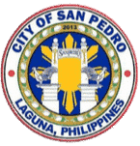About San Pedro City
San Pedro, officially the City of San Pedro (Tagalog: Lungsod ng San Pedro), is a 3rd class component city in the province of Laguna, Philippines. According to the 2020 census, it has a population of 326,001 people. It is named after its patron saint, Peter the Apostle. San Pedro has been dubbed as “dormitory town” of Metro Manila and migrants from other provinces commuting everyday through its highly efficient road and transport system. Despite being one of the smallest political units in the entire province, with a total land area of only 24.05 km2, San Pedro is the 5th most populous city (out of 6) after the cities of Calamba, Santa Rosa, Biñan and Cabuyao. The city also has the highest population density in the province of Laguna and in the whole Calabarzon region, having 14,000 people/km2. As a first class municipality, it became a component city of Laguna by virtue of RA 10420 dated March 27, 2013.
San Pedro is located in Region IV-A or Calabarzon. San Pedro is the boundary between Laguna and Metro Manila, so San Pedro is known as “Laguna’s Gateway to Metro Manila”. San Pedro shares boundaries with Metro Manila’s southernmost city, Muntinlupa (North) bounded with Tunasan River, Biñan (South), Dasmariñas (West), Carmona and Gen. Mariano Alvarez (Southwest) bound with San Isidro River. Its position makes San Pedro a popular suburban residential community, where many residents commute daily to Metro Manila for work.
Mission
Deliver the highest quality of basic services to our constituents while optimizing our resources in accordance with the statutory requirements and our core values.
Vision
San Pedro City: A leading recognized smART City in CALABARZON by 2032.
CORE VALUES
Selflessness Professionalism Courage
Adaptability Excellence Innovation
Nobility Dedication Teamwork
Respect Yes to Life
Obedience
TAGLINE
Unveiling Strategic Leadership
New Advancement Accountability
Age of Good Governance
Unparalled service
Neutrality
Acknowledgement
The Area of where the modern city of San Pedro is found served as the native settlement of the Tagalogs centuries before Spanish contact. The Laguna de Bay and the San Isidro River gave livelihood and food to the early settlers. The Laguna Copperplate Inscription dated back to 900 AD mentioning the ancient polity of Tondo was found on Lumban, Laguna giving the idea that the area of San Pedro which some independent Ancient Barangays headed by their own Datus are settled was under the influence if not directly under the alliance network of the Lakan of Tondo.
On January 16, 1571, it was announced by Miguel López de Legazpi that a settlement called “Tabuko” which is an old Tagalog term that means “the end part of the river” be converted to an encomienda or a town under the helm of Gaspar Ramirez. A month after Miguel López de Legazpi established Manila as the capital of Spanish East Indies, Legazpi’s grandson and conquistador Juan de Salcedo, while exploring the region of Laguna de Bay, founded a settlement in Biñan which was annexed as a barrio to Tabuko, a large town which also then comprised what are now the cities of San Pedro, Santa Rosa, and Cabuyao.
Quality Policy
The City Government of San Pedro is committed to excellent delivery of basic services, functions and facilities to its constituents through the efficient use of its resources guided by its core values.
In pursuit of this commitment, we stretch our collective efforts to render the same in accordance with the standards set by ISO 9001:2015, and applicable legal statutory and regulatory requirements, consistent with our passion for continual improvement to sustain the satisfaction of our internal and external clients

